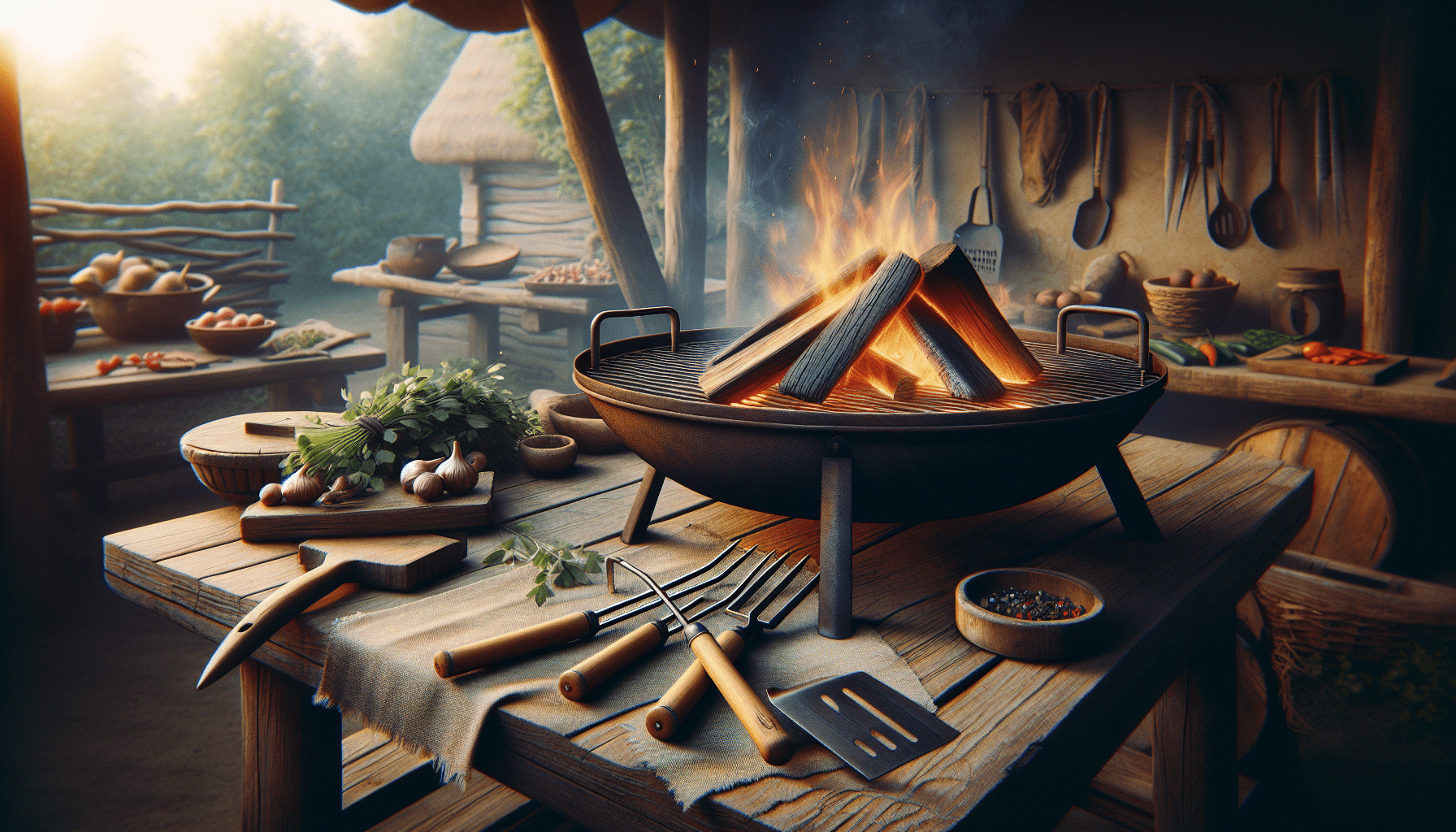Have you ever felt the hypnotic allure of a wood fire grill, the smoky scent filling the air, and the promise of that oh-so-satisfying char? Cooking over an open flame can be a deeply rewarding experience, whether you’re an aspiring chef or someone who just enjoys a good meal outside. You might be wondering where to start or how to elevate your grilling game. Let’s embark on a journey into the rustic charm and culinary joys of wood fire grilling.

Understanding Your Wood Fire Grill
Understanding the mechanics of your wood fire grill is vital for an enjoyable cooking experience. Unlike gas or charcoal grills, wood fire grills rely on the characteristics of wood to provide unique flavors and heat profiles. When you get to know your grill, you set the stage for culinary excellence.
Components of a Wood Fire Grill
A wood fire grill consists of several important parts:
- Firebox: This is where you’ll place your wood for combustion.
- Grill Grates: The cooking surface where your food will rest. The material can vary from stainless steel to cast iron.
- Ventilation: Essential for controlling airflow, which in turn regulates flames and heat.
Knowing these components can enhance your grilling skills. It’s like having a great cast of characters in a play; each one plays a pivotal role.
Types of Wood for Grilling
Choosing the right wood can dramatically influence the flavors you impart to your food. Here’s a quick rundown of popular options:
| Wood Type | Flavor Profile | Best With |
|---|---|---|
| Oak | Strong, smoky flavor | Red meat, vegetables |
| Mesquite | Intense, earthy | Beef, brisquette |
| Fruitwoods | Sweet and mild | Chicken, pork, fish |
| Hickory | Bacon-like smokiness | Ribs, sausage |
| Cherry | Sweet and fruity | Poultry, duck, desserts |
Understanding the characteristics of different woods helps you choose the one that complements your dish. Choose wisely, and the flavors will dance on your palate.
Preparing Your Cooking Area
Preparation makes all the difference when it comes to grilling. You wouldn’t start a painting without first setting up your canvas. Similarly, a well-prepared cooking area paves the way for a successful grilling experience.
Safety First
Fire is both a friend and a foe. Always ensure safety measures are in place. Keep water or a fire extinguisher nearby and maintain a safe distance from flammable materials.
Cleaning Your Grill
Before getting started, give your grill a good clean. Remove any leftover ash or debris to ensure proper airflow. A clean grill is like a blank canvas waiting to catch the colors of your masterpiece.
Preparing the Wood
Choosing the right wood is just the beginning. Split your wood into smaller pieces to help with easier ignition and improved control of heat. A mix of smaller kindling and larger logs creates a better burn and more consistent heat.
Lighting Your Wood Fire Grill
Lighting your wood fire grill may seem daunting at first, but once you get the hang of it, it’s effortless. You’re essentially setting a stage for a culinary performance that’s about to unfold.
Methods for Starting the Fire
There are various methods to ignite your wood fire grill, but two popular ones are:
-
The Top-Down Method: Place larger logs at the bottom, followed by smaller ones, and finally top it off with kindling. This method allows heat to rise, igniting smaller pieces first and minimizing smoke.
-
The Bottom-Up Method: Arrange kindling and small pieces of wood at the bottom, then place larger logs on top. This method is quick but can create a lot of smoke initially.
Managing Airflow
Air control is crucial for regulating flames and heat. Most wood fire grills come with adjustable vents to help you manage airflow. Open airflow promotes a hotter fire, while reduced airflow allows for lower temperatures, ideal for slow cooking.

Temperature Control: The Heart of Grilling
Controlling temperature is fundamental to cooking food evenly. You want to achieve that perfect sear while keeping the inside tender and juicy. Think of it as a delicate dance between confidence and restraint.
Direct vs. Indirect Heat
Understanding the difference between direct and indirect heat can be a game-changer.
-
Direct Heat: Cooking food directly over the flame. This method is perfect for burgers, steaks, and anything that benefits from a quick sear.
-
Indirect Heat: Cooking food next to the flame, allowing for slower and more even cooking. Ideal for larger cuts of meat, like whole chickens or briskets.
Experimenting with both methods will give you the skills to handle any grilling scenario, much like a seasoned performer knows when to take the spotlight.
Utilizing a Heat Gauge
If your grill doesn’t have a built-in thermometer, consider investing in one. Knowing your temperature enables you to make necessary adjustments while cooking. If your grill gets too hot, you want to know before your pork chops turn into charcoal briquettes.
Grilling Techniques to Master
The techniques you use during grilling can elevate your food from good to extraordinary. Cooking over a wood fire requires a bit of strategy, but it’s easier than you might think.
Searing
Searing is all about getting that beautiful outer crust while maintaining the juices inside. Begin with high heat, placing your protein on the grill grates until a golden crust forms. Flip it only once to avoid losing precious juices.
Smoking
If you want to add a deeper flavor to your meats, you can try smoking. This involves cooking food at lower temperatures for extended periods, usually relying on wood chips. A general rule of thumb is to use fruitwoods for poultry and hickory or mesquite for red meat.
Rotisserie
Some wood fire grills come with a rotisserie attachment, allowing you to cook meat evenly while self-basting. The key here is low and slow. It’s like watching a slow-magic trick unfold before your eyes.
Tips for Cooking Various Foods
Cooking on a wood fire grill is not limited to meats alone. There’s a whole world of possibilities that lends itself perfectly to the grill’s flavors.
Meats
When grilling meats, marinate them ahead of time to infuse flavor. A simple marinade of olive oil, garlic, and herbs goes a long way. Allow your meat to sit at room temperature for about an hour before grilling. This helps achieve even cooking.
Fish
Fish can be a delicate option, but when done right, it shines. Opt for thicker fillets, and consider using a cedar plank to prevent sticking. Fish cooks quickly, so keep an eye on it.
Vegetables
Fire-roasted vegetables are a gift to your taste buds. Cut your veggies into uniform sizes for even cooking. Coat them in oil, salt, and herbs before placing them on the grill for savory delight.
Fruits
Yes, fruits can also be grilled! Pineapple, peaches, and watermelon take on a whole new character when kissed by the flames. The sugars caramelize, intensifying their sweetness.
Finishing Touches and Resting
After you feel that the cooking is done, your work isn’t over yet. The final touches and resting period are just as crucial.
Sauces and Glazes
A delicious sauce can take your grilled foods to new heights. Consider preparing a glaze with a mix of balsamic vinegar, honey, and soy sauce for that sweet and tangy finish. Brush it on during the last few minutes of cooking for maximum flavor impact.
Resting the Meat
Letting your meat rest after it comes off the grill allows the juices to redistribute. Generally, a good resting period ranges from 5 to 15 minutes, depending on the size of your cut.
Cleanup: The Final Act
As the curtain falls on this grand culinary performance, don’t forget about the cleanup. It’s the unsung hero that can leave you with a smile or a frown.
Ash Disposal
After your grill has cooled down, dispose of the ashes properly. They can be used in compost, garden beds, or added to soap for natural cleaning. But make sure that they are completely cool before handling.
Grate Cleaning
Use a grill brush to scrub down your grate when it’s still warm (but not too hot!). This makes for easier cleaning.
Store Your Grill Properly
If you won’t be using your grill for an extended period, cover it to protect it from the elements. A well-maintained grill will be your faithful companion for years.
Embracing Your Wood Fire Grilling Journey
Cooking with a wood fire grill can turn an ordinary backyard meal into a festive occasion. As you refine your skills through practice, you’ll discover that the art of grilling can be as rewarding as the final plate.
Invite Friends and Family
Share this delightful cooking experience with your loved ones. Grilling has a way of bringing people together, sparking conversations and laughter around the flames.
Keep Learning
The culinary world is vast and filled with opportunities for growth. Keep experimenting with different woods, techniques, and recipes. Each meal can be a new chapter in your evolving cooking story.
Celebrate Your Victories
Finally, celebrate every grilling triumph, whether it’s mastering the perfect steak or an adventurous foray into grilling pineapple. Cooking should be fun, and each success deserves recognition.
By embracing the charm and techniques of wood fire grilling, you can transform your outdoor cooking experience. With this guide in hand, you can confidently fan the flames of your culinary creativity, savoring the delicious results of your hard work. Now go ahead, light that fire, and enjoy the journey!

